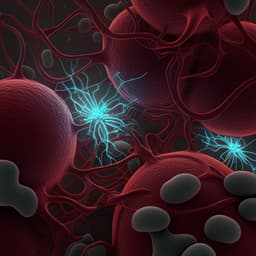
Physics
Transition from a polaronic condensate to a degenerate Fermi gas of heteronuclear molecules
M. Duda, X. Chen, et al.
This groundbreaking research conducted by Marcel Duda, Xing-Yan Chen, Andreas Schindewolf, Roman Bause, Jonas von Milczewski, Richard Schmidt, Immanuel Bloch, and Xin-Yu Luo details a fascinating phase transition in a Bose-Fermi mixture, leading to the creation of sodium-potassium molecules with remarkable dipole moments in a novel quantum-degenerate regime.
~3 min • Beginner • English
Introduction
Mixtures of interacting bosons and fermions provide a platform where beyond-Fröhlich physics arises, including the binding of bosons and fermions into fermionic molecules and the competition between mediated interactions and bound-state formation. This competition yields an enriched phase diagram with possible phases such as supersolids, charge-density waves, molecular Fermi liquids, and boson-induced superconductivity. Prior experiments largely probed impurity limits (Bose or Fermi polarons), but it remained unclear how the transition from atoms to molecules proceeds when bosonic impurities are degenerate and densities are comparable, where mutual dressing is strong. Accessing this density-matched, strongly correlated regime is also key for efficiently creating heteronuclear molecules at high phase-space density, yet it is hampered by fast interspecies losses due to the high density of the BEC. The study aims to probe the predicted quantum phase transition (QPT) between a polaronic condensate (BEC coexisting with a Fermi sea) and a molecular Fermi gas in the low-temperature, density-matched regime and to leverage this transition to form degenerate NaK molecules.
Literature Review
In solid-state systems, electron-phonon coupling is modeled by Fröhlich/Holstein theories. Ultracold atoms and van der Waals materials now realize Bose-Fermi mixtures beyond Fröhlich physics, where bosons and fermions can bind into molecules (refs. 3–8) and reach quantum degeneracy (ref. 9). Theoretical works predict rich phases including supersolidity and charge-density-wave order (refs. 10–13), molecular Fermi liquids (refs. 14–19), and unconventional boson-induced superconductivity (refs. 20,21). Experimentally, Bose polarons were observed for fermionic impurities in a bosonic bath (refs. 22–24) and a polaron–molecule transition is established for impurities in a Fermi sea (refs. 25–28). For degenerate, density-matched mixtures, theory predicts a QPT between polaronic and molecular phases with possible first-order phase separation or a second-order transition (refs. 14,16–18,31,32), and a further transition near nB/nF ≈ 1 where a condensate reappears (ref. 33). On the theory side, NSCT approaches and fRG/diagrammatic methods provide predictions for the polaron-to-molecule transition point, with fRG capturing infinite particle-hole excitations and giving a lower critical interaction in the impurity limit.
Methodology
Experimental platform: A double-degenerate mixture of 23Na (bosons) and 40K (fermions) is prepared. Atoms are loaded via Zeeman-slower (Na) and 2D-MOT (K), cooled, and transferred to an optically plugged magnetic quadrupole trap, followed by optical transport and final trapping. A species-dependent dipole trap at 785 nm is used to decompress Na relative to K, reducing the Na BEC peak density and improving density matching and spatial overlap. Typical trapping frequencies (K): 2π × (72, 90, 187) Hz; (Na): 2π × (23, 28, 61) Hz. Typical initial conditions: 2.3 × 10^5 K atoms at T ≈ 80 nK (T/TF ≈ 0.2) and 0.8 × 10^5 Na atoms with ≈60% condensate fraction at 81 G.
Interaction control and ramps: Interactions are tuned near a broad Na–K Feshbach resonance at 78.3 G (kF R ≈ 0.08). A single magnetic-field ramp at 3.5 G ms−1 is used to traverse interaction strengths parameterized by (kF aBF)−1 while keeping aBB = 53 a0. No collapse or immiscibility is observed on experimental timescales. After reaching the target interaction, a rapid quench to 72.3 G projects the system onto free atoms and deeply bound molecules for detection via time-of-flight imaging with Stern–Gerlach separation.
Order parameter and observables: The normalized order parameter is defined as φ = NBEC / (Nm + NBEC), where NBEC is the number of condensed Na atoms and Nm the number projected into molecules. Thermal Na atoms are excluded due to their minimal contribution in the trap center. Molecule numbers during association and dissociation ramps are measured to infer pairing correlations and the transition point. Velocity distributions of Feshbach molecules are analyzed to determine T/TF.
Comparison to theory: Data are compared to zero-temperature predictions for condensate depletion at equal densities from a non-self-consistent T-matrix (NSCT) theory, and to impurity-limit quasiparticle weights and transition points from self-consistent functional renormalization group (fRG) calculations that include infinite particle-hole excitations. The fRG predicts a polaron-to-molecule transition at (kF aBF)−1 = 1.16 (impurity limit), serving as a lower bound in the many-body mixture. NSCT predicts larger critical values at finite boson density, up to ≈2.02 for nB = nF.
Auxiliary procedures: Association to Feshbach molecules uses multi-stage ramps (fast to 78.6 G, slow across resonance to 77.8 G at 3.5 G/ms, then fast to 75 G). Magnetic-field gradient is adjusted for levitation and removal of unbound atoms, with subsequent trap compression and preparation for ground-state transfer. A control study in a 1550/1064-nm trap (density-mismatched) shows much lower association efficiency (<25%) and significant Na loss, underscoring the importance of density decompression.
Data integrity checks: Ramp-speed dependence of condensate depletion shows consistency for 1.7 and 3.5 G/ms, with shifts at 9 G/ms. Heating near the critical point is characterized (anisotropic), and system remains metastable without collapse on the ramp timescale.
Key Findings
- Observations consistent with a quantum phase transition from a polaronic condensate (BEC + Fermi sea) to a molecular Fermi gas in a density-matched, double-degenerate 23Na–40K mixture.
- The order parameter φ = NBEC/(Nm + NBEC) decreases gradually with increasing attraction and vanishes beyond critical interaction strengths: φ → 0 for (kF aBF)−1 ≈ 1.44(15) at ñB/ñF = 0.7 and ≈ 1.75(18) at ñB/ñF = 0.4.
- An independent estimate from the saturation trend of projected Feshbach molecule numbers yields a transition at (kF aBF)−1 = 1.29(14), consistent with the φ-based estimate.
- Data agree well with NSCT predictions for condensate depletion at low temperature and show near-universal behavior versus boson–fermion density ratio, in line with theory.
- Comparison to impurity-limit theory: fRG predicts the polaron-to-molecule transition at (kF aBF)−1 = 1.16; experimental transition occurs at larger values, as expected due to finite temperature and boson density.
- Efficient molecule production when driving through the transition: conversion efficiency ≈ 80% of BEC Na atoms into Feshbach molecules under near-matched densities; suggests near-unity association under perfect density matching.
- Creation of quantum-degenerate Feshbach molecules: molecular velocity distribution fits a Fermi–Dirac function with T/TF = 0.28(1), evidencing Pauli blocking and degeneracy.
- Subsequent production of ground-state 23Na40K molecules with a large molecular-frame dipole moment of 2.7 debye in the quantum-degenerate regime.
- Control experiments in conventional traps with BEC-dominated density show far lower association efficiency (<25%) and larger interspecies losses, highlighting the efficacy of the density-decompression technique.
Discussion
The results directly address the long-standing question of how a Bose–Fermi mixture with comparable densities undergoes a transition from polaronic dressing to bound molecular states at low temperature. The continuous depletion and eventual disappearance of the BEC order parameter with increasing attraction, together with the growth and saturation of projected molecule numbers, provide consistent signatures of a transition to a molecular Fermi gas. Agreement with NSCT condensate depletion across different density ratios supports theoretical predictions of near-universality and validates comparison to homogeneous zero-temperature theory despite trap inhomogeneity. The experimental critical point lies above the impurity-limit fRG value, as anticipated from finite boson density and temperature, and the smooth vanishing of φ near the transition (without a clear jump) reflects trap averaging and possible smoothing from finite density/temperature, making it challenging to distinguish first- from second-order scenarios. Practically, traversing the transition enables highly efficient molecule formation at high phase-space density, producing a degenerate NaK molecular gas that can be transferred to the rovibrational ground state with a large dipole moment, opening pathways to studies of dipolar quantum matter and quantum chemistry.
Conclusion
By engineering a density-matched, strongly interacting 23Na–40K Bose–Fermi mixture and adiabatically tuning interactions, the study observes behavior consistent with a zero-temperature quantum phase transition from a polaronic condensate to a molecular Fermi gas. The condensate fraction serves as an order parameter that vanishes near the critical interaction, corroborated by the growth and saturation of molecule populations. The data align with NSCT predictions for condensate depletion and with impurity-limit fRG expectations for a lower-bound critical point. Exploiting this transition yields highly efficient association of NaK Feshbach molecules and the creation of a degenerate molecular Fermi gas, followed by transfer to ground-state molecules with a 2.7 D dipole moment. These advances provide a powerful route to quantum-degenerate polar molecules and to exploring many-body physics of dipolar systems. Future work should resolve the local critical dynamics and the order of the transition in homogeneous settings (e.g., box traps) with high-resolution imaging, and further optimize adiabaticity to reduce heating near criticality.
Limitations
- Trap inhomogeneity and harmonic averaging smooth the order parameter, hindering a clear discrimination between first- and second-order transitions and masking possible phase separation.
- Heating and non-adiabatic dynamics emerge near the critical point (critical slowing down), with anisotropic energy redistribution, complicating precise thermometry; thermal wings reflect an effective kinetic temperature rather than local equilibrium values.
- Detection relies on rapid projection to deeply bound molecules, which measures short-range pairing correlations; molecule counts before the transition reflect overlap rather than fully formed weakly bound pairs.
- Residual density mismatch and interspecies losses (from excess bosons) limit the absolute conversion efficiency; perfect matching is inferred but not strictly realized.
- The finite boson density and temperature shift the transition relative to impurity-limit predictions; direct zero-temperature, homogeneous benchmarks are not available in this setup.
- Collapse and immiscibility are not observed on the experimental timescale due to rapid ramps; long-time behavior and stability near unitarity remain unaddressed.
Related Publications
Explore these studies to deepen your understanding of the subject.







